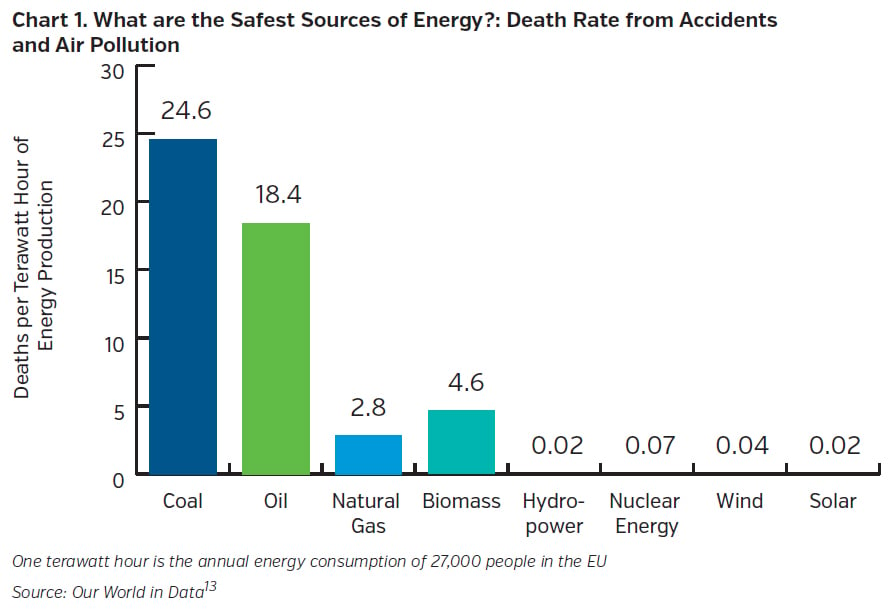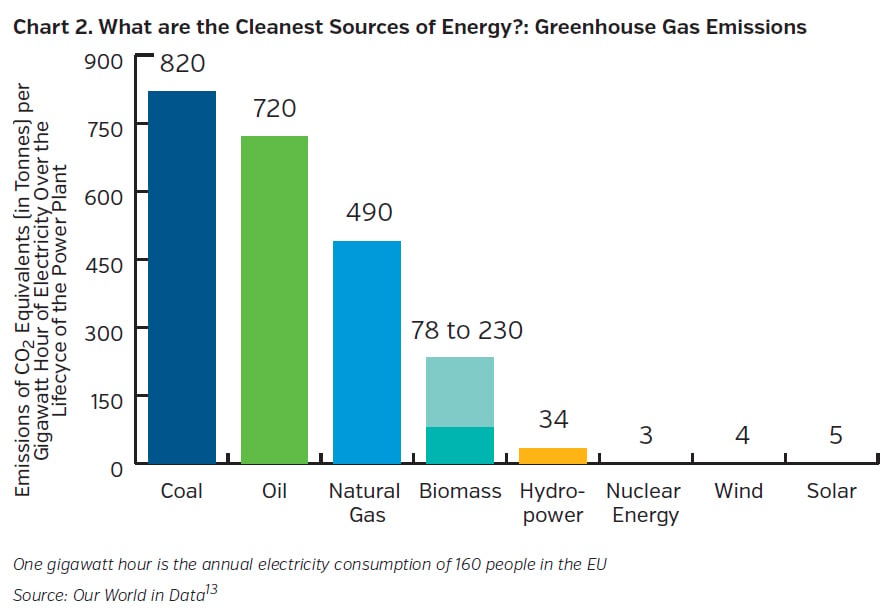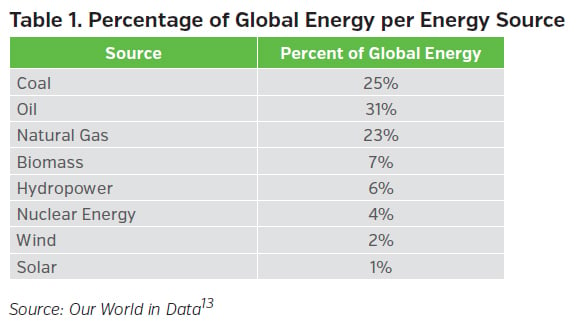Nuclear Power in the U.S.
Green sources of electric power such as wind and solar are appealing as they emit minimal pollution and carbon while producing power. The wind does not blow constantly, however, nor is the sun out around the clock and electric storage technology has not advanced to the point of capturing energy from any source sufficient to power an entire electrical grid. Other forms of energy that run almost continuously – such as nuclear power1 – are required to fill any gaps in production of electricity from the wind or the sun.
What is the state of nuclear electricity generation in the U.S.? Unfortunately, after a strong pace of nuclear power plant construction in the 1970s – 1990s2, the country lost enthusiasm for building new facilities. Construction was expensive, approvals increasingly difficult to obtain and publicity surrounding the relatively few nuclear facility accidents discouraged development.3 The nuclear share of electricity generation in the U.S. rose from 2% in 1971 to around 20% in 1991, where it has remained. In comparison, wind’s share is 9% and solar’s is 3%.4
Nuclear accidents have disproportionately raised public concern compared to the actual record. When judged by fatalities per unit of energy produced, nuclear is superior to coal, oil, natural gas and even biomass. Measured by emissions, nuclear power is comparable to hydropower, wind and solar.5 Furthermore, safety has improved with advances in fuel technology, thermal efficiency, more rugged design, and enhanced systems.6
When pursuing net zero emissions, nuclear power lowers the overall cost of electricity, capital and space required to construct backup power and transmission facilities.7 Considering expenses over the life of energy investments, nuclear power plants are more economical because they operate more than twice as often as solar or wind power (93% of the time vs. 25% for solar and 35% for wind8) and last twice as long. Plants are fueled by relatively cheap and plentiful uranium with large reserves in Australia, Canada and Mongolia.9 A comparison of international energy projects shows wind and solar electricity at roughly three times the all-in cost of nuclear.10 Lastly, emissions fall when nuclear plants replace fossil fuel for electricity. France experienced a greenhouse gas decline of 2% per year as it moved to nuclear from fossil fuels in the 1970s and 1980s11 and the International Energy Agency estimates that net zero emissions by 2050 will need global nuclear power capacity to double to 812 gigawatts from today.12



Global Approach to Nuclear Power
To remain competitive and increase energy independence, the U.S. needs to keep pace with both rivals and allies who are expanding their use of nuclear. Globally, 55 reactors are under construction, including 19 in China, 7 in India and 3 in Russia – all scheduled to be online by 2027.14 Following recent energy price disruptions, the European Union has included nuclear as an “Environmentally Sustainable Investment,”15 with several countries reversing policies phasing out nuclear energy in favor of extending plants’ lifespans and developing new plants, including France,16 Germany17 and the UK.18 In the U.S., licenses have been granted for eight new reactors, though only two are under construction.19 There is promise ahead for the U.S. with federal20 and state21 level directives to extend existing plant lives and refocusing on nuclear power. Advances in reactor design, fuels, and size of facilities provide the opportunity for nuclear energy to improve efficiency, safety and increase electric generation capacity over the coming decades.
Key Takeaways
- Investors need to be aware that nuclear power can and should play a large role in mitigating transition from fossil fuels to renewable sources of energy and lowering global emissions
- Until electrical storage technology can take full advantage of renewable energy’s promise, nuclear power is required to maintain enough energy for economic growth
- As the U.S. proceeds on the path toward environmentally friendly energy alternatives, nuclear power should be included in this mix and can help reduce potentially inflationary forces
- Ahead of transition to low emission and renewable fuels NEAM has shortened maturities of energy holdings in client portfolios
Endnotes
1 U.S. Department of Energy Office of Nuclear Energy, “Nuclear Power is the Most Reliable Energy Source and It’s Not Even Close,” March 24, 2021.
2 “Most U.S. nuclear power plants were built between 1970 and 1990,” Jude Hislop, North American Energy News U.S. Energy Information Administration, Preliminary Monthly Electric Generator Inventory, Nuclear Power.
3 “’Outrageous’ price tag: Plant Vogtle cost doubles to $28.5 billion as other owners balk,” The Augusta Chronicle, November 4, 2021.
4 “Source of US electricity generation, 2021,“ Electric Power Monthly, US Energy Information Administration, February 2022, preliminary data.
5 “What are the safest and cleanest sources of energy?” Hannah Ritchie, February 10, 2020, Our World in Data.
6 “Advanced Nuclear Power Reactors,” World Nuclear Association, Updated April 2021.
7 “Clean Firm Power is the Key to California’s Carbon-Free Energy Future,” Issues in Science and Technology, March 24, 2021.
8 U.S. Department of Energy Office of Nuclear Energy, “Nuclear Power is the Most Reliable Energy Source and It’s Not Even Close,” March 24, 2021.
9 “Leading countries worldwide based on uranium resources in 2020,” Statista, February 28, 2022.
10 “The True Costs of Nuclear and Renewables,” Mathjis Beckers, Market Intelligence, November 12, 2018.
11 “How Nuclear Power Can Stop Global Warming,” Scientific American December 12, 2013.
12 “Global nuclear power capacity in the Net Zero Scenario, 2005-2050,” International Energy Agency, November 2021.
13 Additional details regarding the charts: Life-cycle emissions from biomass vary significantly depending on fuel (e.g. crop resides vs. forestry) and the treatment of biogenetic sources. The death rate for nuclear energy includes deaths from the Fukushima and Chernobyl disasters as well as the deaths from occupational accidents (largely mining and milling). Energy shares refer to 2019 and are shown in primary energy substitutions equivalents to correct for the inefficiencies of fossil fuel combustion. Traditional biomass is taken into account. Data sources: Death rates from Markandya and Wilkinson (2007) in The Lancet, and Sovacool et al. (2016) in Journal of Cleaner Production; Greenhouse gas emission factors from IPCC AR5 (2014) and Pehl et al. (2017) in Nature; Energy shares from BP (2019) and Smil (2017). OurWorldinData.org - Research and data to make progress against the world's largest problems. Licensed under CC-BY by Hannah Ritchie and Max Roser.
14 “Plans for New Reactors Worldwide,” World Nuclear Association, Updated March 2022.
15 “Uranium Royalty Corp. Corporate Presentation, May 2022.
16 “France: Nuclear regulator approves extension to 50 years,” Teller Report February 25, 2021.
17 “Germany mulls extending nuclear plants' life-span - economy minister,” Reuters, February 27, 2022.
18 “Boris Johnson ‘plans for UK to get 25% of energy from nuclear,’ Energy Live News, March 22, 2022.
19 “Map of nuclear power in the US: See where reactors are located,” CNBC, April 7, 2022, sourced from US Nuclear Regulatory Commission as of October 2021.
20 “Biden launches $6B effort to save distressed nuclear plants,” Associated Press, April 19, 2022.
21 “Governor Newsom Considers Keeping Diablo Canyon Nuclear Plant Open Past 2025,” Evan Symon, California Globe, April 30, 2022.









